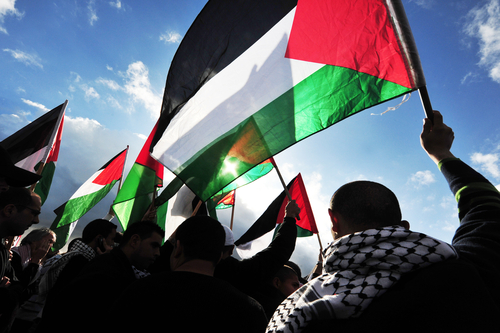52 Palestinians killed on deadliest day since 2014: Gaza
At least 52 Palestinians have been killed and 2,400 wounded by Israeli troops, Palestinian officials say, on the deadliest day of violence since the 2014 Gaza war.
Palestinians have been protesting for weeks but deaths soared on the day the US opened its embassy in Jerusalem.
Palestinians see this as clear US backing for Israeli rule over the whole city, whose eastern part they claim.
But US President Donald Trump hailed the move in a video message.
He told the dedication ceremony that it had been a “long time coming”, adding: “Israel is a sovereign nation with the right to determine its own capital but for many years we failed to acknowledge the obvious.”
The US, he added, remained “committed to facilitating a lasting peace agreement”.
What happened at the border?
There have been six weeks of protests at the Gaza border, dubbed the “Great March of Return” and led by Gaza’s Islamist rulers Hamas.
Hamas had always said it would step up the protests before Tuesday, when Palestinians hold their annual commemoration of what they call the Nakba or Catastrophe. Hundreds of thousands fled their homes or were displaced following the foundation of the Israeli state on 14 May 1948.
On Monday, the Israeli military said 40,000 Palestinians had taken part in “violent riots” at 13 locations along the Gaza Strip security fence.
Palestinians hurled stones and incendiary devices while the Israeli military used snipers, as black smoke poured from burning tyres.
The health ministry, run by Hamas, said children were among those killed.
The Israeli military said it had killed three people trying to plant explosives near the security fence in Rafah. Aircraft and tanks had also targeted military positions belonging to Hamas in the northern Gaza Strip, it said.
Israel says the protests are aimed at breaching the border and attacking Israeli communities nearby.
There were also violent clashes between Israeli police and protesters who raised Palestinian flags outside the new embassy. Several protesters were detained.
By no means over
Feras Kilani, BBC Arabic, at the protests in Gaza
Tuesday is expected to be a very big demonstration because it is a day known by the Palestinians as the “Catastrophe” that followed the creation of the state of Israel.
Palestinians will go to bury the dozens of people killed on Monday and then they will come again to demonstrate. You can imagine the situation with all this anger, thousands of Palestinians will come here and will try to cross the fence to return to what they see as their land – what they do not see as Israel but as Palestine.
It is expected to be bigger than Monday and more bloody.
What has the reaction been?
Palestinian Authority leader Mahmoud Abbas condemned what he called Israeli “massacres against our people”, and declared three days of mourning.
Israeli PM Benjamin Netanyahu said: “Every nation has the right to defend its borders. Hamas clearly says its intentions are to destroy Israel and sends thousands to break through the border for that end.”
A number of Western nations including the UK called for restraint.
- EU foreign policy chief Federica Mogherini said: “We expect all to act with utmost restraint to avoid further loss of life”
- Germany said Israel had the right to defend itself but should do so proportionately
- One of the strongest statements came from UN High Commissioner for Human Rights Zeid Ra’ad al-Hussein, who condemned the “shocking killing of dozens, injury of hundreds by Israeli live fire”
What has the US opened and who attended?
A small interim embassy will start operating from Monday inside the existing US consulate building in Jerusalem. A larger site will be found later when the rest of the embassy moves from Tel Aviv.
The opening ceremony was brought forward to coincide with the state of Israel’s 70th anniversary.
Mr Trump’s daughter, Ivanka, and her husband Jared Kushner, who are both senior White House advisers, joined US Treasury Secretary Steven Mnuchin and Deputy Secretary of State John Sullivan for the ceremony.
After Ivanka Trump had unveiled the seal of the embassy, Mr Kushner said in his address: “When President Trump makes a promise he keeps it… We have shown the world that the US can be trusted. We stand with our friends and allies.”
Mr Kushner also referred to Mr Trump’s withdrawal from the “dangerous, flawed and one-sided Iran deal”, drawing applause from the guests.
Mr Netanyahu said: “What a glorious day. Remember this moment. This is history. President Trump, by recognising history, you have made history. All of us are deeply grateful.”
Mahmoud Abbas condemned the embassy as a “settlement in East Jerusalem”, saying that the US was “no longer a mediator in the Middle East”.
Arab League chief Ahmed Abul Gheit said it was “shameful to see countries participating with the US and Israel in celebrating the former’s embassy move to occupied Jerusalem in a clear and grave violation of international law”.
Why is the embassy move so controversial?
The status of Jerusalem goes to the heart of the Israeli-Palestinian conflict.
Israeli sovereignty over Jerusalem is not recognised internationally and, according to the 1993 Israel-Palestinian peace accords, the final status of Jerusalem is meant to be discussed in the latter stages of peace talks.
Israel has occupied East Jerusalem since the 1967 Middle East war. It effectively annexed the sector, though this was not recognised by any countries until Mr Trump’s declaration in December 2017.
Since 1967, Israel has built a dozen settlements, home to about 200,000 Jews, in East Jerusalem. These are considered illegal under international law, although Israel disputes this.
Various countries once had embassies based in Jerusalem but many moved after Israel passed a law in 1980 formally making Jerusalem its capital.

